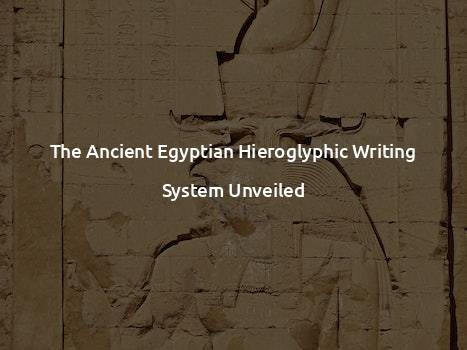The Ancient Egyptian Hieroglyphic Writing System Unveiled
The Ancient Egyptian Hieroglyphic Writing System Unveiled
Ancient Egypt, with its rich history and fascinating civilization, has left behind numerous remnants of its culture, art, and knowledge. One of the most distinctive and iconic features associated with ancient Egypt is the hieroglyphic writing system. This intricate system of pictorial symbols, known as hieroglyphs, was used by ancient Egyptians to communicate, record information, and convey their beliefs.
The Origins of Hieroglyphics
The ancient Egyptian hieroglyphic writing system is believed to have emerged around 3300 BCE, making it one of the oldest recorded writing systems in the world. The term “hieroglyphics” is derived from the Greek words “hieros,” meaning sacred, and “glyphein,” meaning to carve, emphasizing the sacred and carved nature of these symbols.
The origins of hieroglyphics can be traced back to the early stages of Egyptian civilization when ancient Egyptians started using pictures to represent objects and ideas. These pictorial representations gradually evolved into a complex system of symbols, combining both logographic and phonetic elements. Logographic symbols represented complete words or concepts, while phonetic elements denoted individual sounds or syllables.
The Complexity of Hieroglyphics
The hieroglyphic writing system is exceptionally intricate, comprising over 700 individual symbols. These symbols encompass a wide range of categories, including phonograms (representing sounds), determinatives (expressing word meaning and context), and ideograms (conveying ideas or concepts).
One of the fascinating aspects of hieroglyphics is its flexibility. Symbols could be written in various directions, including left to right, right to left, and top to bottom. Moreover, hieroglyphics did not include vowels, further complicating the reading and interpretation process. The reader was expected to know the words and context to decipher the intended meaning correctly.
The Uses and Importance of Hieroglyphics
Hieroglyphics were not exclusively used for recording historical events and religious beliefs but also had practical applications in everyday life. The writing system was employed in areas such as administrative records, legal documents, tombs, and monuments.
However, hieroglyphics were primarily associated with the sacred and religious aspects of ancient Egyptian culture. These symbols were deeply intertwined with the elaborate religious rituals, myths, and tales of gods and goddesses that characterized ancient Egyptian society. Hieroglyphs adorned the walls of temples and tombs, conveying the divine stories and spiritual journeys of the pharaohs and their people.
The Rosetta Stone: Decoding the Mystery
For centuries, hieroglyphics remained an enigma to scholars and archaeologists. It was not until the discovery of the Rosetta Stone in 1799 that a breakthrough occurred in deciphering this ancient writing system.
The Rosetta Stone, an ancient Egyptian artifact discovered by a French soldier, contained inscriptions in three scripts: hieroglyphic, demotic (another form of ancient Egyptian writing), and Greek. By comparing the known Greek text with the Egyptian scripts, scholars were able to unlock the code and decipher the hieroglyphics. This remarkable discovery opened up a wealth of knowledge about ancient Egyptian history, culture, and religion.
TLDR;
The ancient Egyptian hieroglyphic writing system was an intricate and sacred method of communication. It emerged around 3300 BCE and consists of over 700 complex symbols that combine logographic and phonetic elements. Hieroglyphics were used for various purposes, including recording historical events, administrative records, and religious rituals. The Rosetta Stone’s discovery in 1799 enabled scholars to crack the code and decipher this ancient writing system, unveiling a treasure trove of knowledge about ancient Egyptian civilization.







